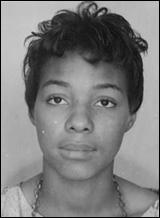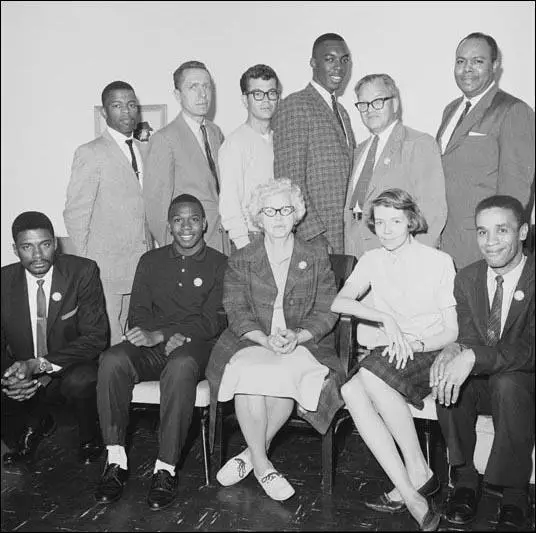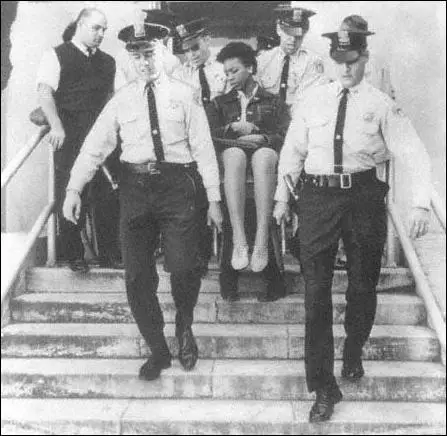Doris Jean Castle

Doris Jean Castle was born in Oakland, Tennessee, on 25th May, 1942. The family moved to New Orleans in 1947. She graduated from Joseph S. Clark High School and attended Southern University. Along with her sister, Oretha Castle, she became involved in the struggle for civil rights helped to establish the New Orleans chapter of the Congress of Racial Equality (CORE) and her parent's house became known as "Freedom House". (1) The two sisters organized a boycott to fight the racially discriminatory employment practices of Dryades Street merchants. (2)
In February, 1961, CORE organized a conference in Kentucky where the organization laid out its plans to have Freedom Riders challenge the racist policies in the south. It was decided they would ride interstate buses in the South in mixed racial groups to challenge local laws or customs that enforced segregation in seating. (3) John Lewis, a student at Nashville American Baptist Theological Seminary, commented later: "At this time human dignity is the most important thing in my life. This is the most important decision in my life, to decide to give up all if necessary for the Freedom Ride, that Justice and Freedom might come to the Deep South." (4)
Walter Bergman was one of those who volunteered to take part in the Freedom Rides and the training was organized by James Farmer. "Fourteen of us went into training for three days in nonviolent techniques, Gandhi - and Martin Luther King Jr. - type techniques. We had to be absolutely nonviolent, no matter what happened to us. On the last day, the leader, James Farmer, asked, 'Will each of you under all circumstances, no matter what the provocation, refrain from reacting violently?' I was sixty at the time, and it wasn't too difficult for me to say I'd be nonviolent. But there was one young man (John Moody), a big football player, who said, 'I don't know. If some southern sheriff comes up and tells me that I've got to move along and starts to shove me, I just can't say that I won't shove back.' So James Farmer said, 'Well, we'll have to leave you behind.' That made only thirteen of us, six whites and seven Blacks." (5)
The first bus left Washington on 4th May, 1961, for Georgia, Alabama and Mississippi. Members of CORE who traveled on the bus included John Lewis, James Peck, Ed Blankenheim, Hank Thomas, Walter Bergman, Frances Bergman, Genevieve Hughes, James Farmer, Benjamin Elton Cox, Charles Person and Jimmy McDonald. Farmer later recalled: "We were told that the racists, the segregationists, would go to any extent to hold the line on segregation in interstate travel. So when we began the ride I think all of us were prepared for as much violence as could be thrown at us. We were prepared for the possibility of death." (6)

John Lewis, James Peck, Ed Blankenheim, Hank Thomas, Walter Bergman
and James Farmer. Bottom, left to right: Benjamin Elton Cox, Charles Person,
Frances Bergman, Genevieve Hughes and Jimmy McDonald.
Doris Castle was a strong supporter of the Freedom Riders. Her house became the unofficial headquarters of CORE in New Orleans and several riders spent the night there. This upset the South Louisiana White Citizens' Council called the Freedom Riders as "a lawless, radical group" and asked the authorities to "rid the community of these agitators before violence erupts". When a reporter suggested that the Freedom Ride had failed, Benjamin Elton Cox, replied: "It proved what we set out to prove - that American citizens cannot travel freely in the United States. Laws are on the books, but they are not being enforced." (7)
On 24th May, 1961, the day before her 18th birthday, Doris Castle joined with James Farmer, John Lewis, Ed Blankenheim, John Moody, Jerome Smith, Peter M. Ackerberg, Lucretia R. Collins, John Lee Copeland, Dion Tyrone Diamond, Grady H. Donald, Frank George Holloway, Ernest Patton, Hank Thomas, Clarence Lloyd Thomas and Leroy Glenn Wright traveled from Montgomery, Alabama, to Jackson, Mississippi. (8) Castle told Keith Weldon Medley: “Those on the bus with us were a group of people who had never been in each other’s company, bonded by a common goal. Our only weapon was that we were right in what we were doing.” (9)
Doris Castle continued to campaign against segregation in New Orleans. "During a 1963 protest of the segregated New Orleans City Hall cafeteria, police carried Castle, still in her cafeteria chair, from the building after she refused to leave. She was one of three plaintiffs who successfully sued to desegregate the facility. Working alongside her sister, Castle also helped to desegregate public transportation in New Orleans." (10)

Doris Castle explained about her campaign against segregation in cinemas: "Since November 1963 New Orleans CORE had been picketing three downtown theaters urging that they admit Negroes. It is the end of March 1964 and the situation called for new techniques. So on Good Friday, nine of us joined the line of patrons at the ticket window of Loew's State. The line moved briskly. The first of our group reached the window and placed her money on the counter. It was not the ticket seller but the assistant manager standing nearby who refused to sell the ticket. One by one, we followed. Each was refused, without explanation. The last of our group, Alice Thompson, then walked behind the ticket booth. We joined her, linked hands and completely surrounded the booth forming a "Freedom Ring." We began to walk in a circle. The surprised patrons fell back into the quickly-gathering crowd of spectators. A few held their places in line. One man tried to break through our ring but failed. While we circled the booth, police conferred with the dejected theater manager. Then a policeman came over to our group and asked us each, individually, to leave. We refused. He placed us under arrest. We sat down, still in circle formation. Policemen then lifted each of us onto a hand-truck, rolled us to the paddy-wagon and took us to jail. It was a first arrest for Katrina Jackson and Harold Sullivan. Shirley Thompson, Ruth Wells, Linda and Dorotha Smith and Alicia Joseph had been arrested before. I had been arrested five times in the course of New Orleans CORE's years of nonviolent." (11)
Doris Jean Castle, who was married and divorced twice to Johnny Jackson Jr. and Allen Scott, died of cancer in 1998. (12)
Primary Sources
(1) Doris Jean Castle, CORE-Lator (March-April, 1964)
Since November 1963 New Orleans CORE had been picketing three downtown theaters urging that they admit Negroes. It is the end of March 1964 and the situation called for new techniques. So on Good Friday, nine of us joined the line of patrons at the ticket window of Loew's State. The line moved briskly. The first of our group reached the window and placed her money on the counter. It was not the ticket seller but the assistant manager standing nearby who refused to sell the ticket.
One by one, we followed. Each was refused, without explanation. The last of our group, Alice Thompson, then walked behind the ticket booth. We joined her, linked hands and completely surrounded the booth forming a "Freedom Ring." We began to walk in a circle. The surprised patrons fell back into the quickly-gathering crowd of spectators. A few held their places in line. One man tried to break through our ring but failed.
While we circled the booth, police conferred with the dejected theater manager. Then a policeman came over to our group and asked us each, individually, to leave. We refused. He placed us under arrest. We sat down, still in circle formation. Policemen then lifted each of us onto a hand-truck, rolled us to the paddy-wagon and took us to jail.
It was a first arrest for Katrina Jackson and Harold Sullivan. Shirley Thompson, Ruth Wells, Linda and Dorotha Smith and Alicia Joseph had been arrested before. I had been arrested five times in the course of New Orleans CORE's years of nonviolent
(2) New Orleans Volunteer Association, Doris Jean Castle (April 1998)
Doris Jean Castle, a former Freedom Rider and longtime Civil-Rights activist, died Tuesday of cancer at her home. She was 55. At the height of the movement in the 1960s to end segregation, Ms. Castle and her late sister, Oretha, turned their parents' home in the 6th Ward into what they called a 'Freedom House,' welcoming Civil-Rights workers, both black and white, who were passing through New Orleans and needed a place to stay. "Our house was like a Way Station,' said Ms. Castle's younger brother, Johnny. "Like the Underground Railroad. I'd be getting ready for school in the morning and there would be five or six people in the household that I had never seen before. By the time I'd come home, there could be five or six more." The workers, mostly young people on their way to a march or demonstration somewhere In the south, were given food and a bed, or at least a place to sleep, and lots of encouragement by Ms. Castle and her family. The scene made for lively conversation, full of news of the movement In other cities, punctuated occasionally by visits from celebrities, including James Farmer, founder of the Congress of Racial Equality, and novelist James Baldwin, who held forth In spellbinding fashion in the Castles' living room, Johnny Castle said. "There was a romantic side to the movement," He said. "They were doing things to change the lives of black people - and white people, too. My sisters were caught up in that romance."
Born in Oakland, Tenn., Ms. Castle came to New Orleans with her parents and siblings In 1947. She graduated from Joseph S. Clark High School and attended Southern University at New Orleans. In mid-1961, she boarded a Greyhound bus bound for Mississippi and joined the ranks of the Freedom Riders, challenging segregated facilities along the way and defying threats that the bus would be burned when it reached its destination. The Riders "vowed they would burn with the bus," Castle said. "They wouldn't get off. I remember some kind of visible anxiety as my parents were sitting, watching, listening," he said. A few years later, Ms. Castle was carried out of city hall when she joined the Rev. Avery Alexander in trying to desegregate the building's cafeteria. She and her sister helped to desegregate New Orleans Public Service Buses, worked for Voter Registration and joined a boycott of Dryades Street Stores to push for equal employment opportunities for black residents.
(3) The Historic New Orleans Collection: Doris Jean Castle (1998)
A civil rights activist who dedicated her life to social service, Doris Jean Castle was the younger sister of the civil rights icon Oretha Castle Haley. As a teenager, Castle joined in a boycott and protests organized by the Consumers’ League of Greater New Orleans to fight the racially discriminatory employment practices of Dryades Street merchants. An early member of the New Orleans chapter of the Congress of Racial Equality (CORE), she served as the membership chair of the organization and actively engaged in picketing segregated Canal Street businesses.
Castle courageously participated in the 1961 Mississippi Freedom Rides and was arrested in Jackson, Mississippi. She and her fellow riders refused to pay bail, choosing to serve prison time as a tactic to keep the media’s attention. Castle served some of her time at the Mississippi State Penitentiary in Parchman, which was notorious for its particularly harsh conditions. The following year she participated in CORE’s "Freedom Highways," a campaign challenging segregated facilities along major highways.
During a 1963 protest of the segregated New Orleans City Hall cafeteria, police carried Castle, still in her cafeteria chair, from the building after she refused to leave. She was one of three plaintiffs who successfully sued to desegregate the facility. Working alongside her sister, Castle also helped to desegregate public transportation in New Orleans.
In the mid-1960s she left the city to raise funds for the National Welfare Rights Organization. After she returned to New Orleans in 1967, Castle worked for several social service programs, including some under the auspices of Lyndon Johnson’s War on Poverty initiative. She worked with the Urban League to challenge housing discrimination and served as a counseling specialist with Odyssey House, a behavioral healthcare facility focused on addiction treatment. Later in life she worked as an admissions supervisor at Charity Hospital.
(4) Keith Weldon Medley, The New Orleans Tribune (12th July, 2016)
“Those on the bus with us were a group of people who had never been in each other’s company, bonded by a common goal. Our only weapon was that we were right in what we were doing.” Doris Castle, a 17-year-old Freedom Rider from New Orleans in a 1986 interview with the writer.
What began as a demonstration to win enforcement of a six-year-old Interstate Commerce Commission ruling prohibiting segregation in travel, the Freedom Rides exploded into a defining battle of equality versus racial supremacy. The people who embarked on this harrowing journey fought for a cause higher than themselves. In May of 1961, James Farmer launched a two-week bus ride from Washington D.C. to New Orleans to test segregated facilities along the way. Farmer called the action a “sit-in on wheels.” On May 4, 1961, a contingent of seven Blacks and six Whites left Washington, DC, aboard a Greyhound bus. They intended to reach New Orleans on May 17 with stops in Birmingham, Montgomery and Jackson. But as the bus dipped deeper into the South, the number and intensity of racial incidents increased. In Charlotte, N.C., police arrested 27-year-old James Peck who attempted to get a shoeshine at a barbershop in the terminal. In Rock Hill, S.C., youths attacked future United States Congressman John Lewis and two White CORE members when Lewis refused to leave the White waiting area.
On May 12, the group reached Atlanta. After mapping out details for the next phase, they recruited additional riders and boarded a Greyhound and a Continental Trailways bus to Birmingham. The scene turned ugly outside Anniston, Ala. A Ku Klux Klan organized mob of 100 segregationists laid in wait. After repeated unsuccessful attempts to board the bus, segregationists flung a firebomb through an open window that injured 12 passengers. The flames eventually consumed the bus. In Birmingham, a large group of segregationists occupied the terminal, sealing off exits and blocking access to telephones. After a Black CORE member defiantly entered the “White Only’ reception area, a group of 30 segregationists surrounded him, shoved him backwards and punched him repeatedly in his face. After assessing their position the next day, CORE decided to cancel the remainder of the trip. In the course of their two-week trek, over 25 people had been injured. Three had been arrested, and a bomb had destroyed a bus. For the moment, it seemed that the desegregation of transportation facilities would have to wait.
